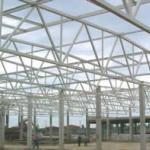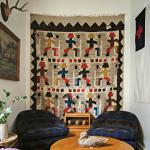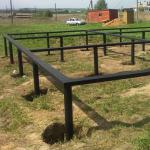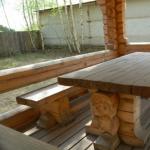In many cases, a pile foundation is preferable to other types of foundations, especially in the field of low-rise construction, as it allows significant savings on its construction. The stage of tying screw piles with timber is mandatory and is one of the most difficult and responsible. But before considering the procedure for carrying it out, it is necessary to understand why this needs to be done and how important quality is.
What is a pile? A hollow pipe made of high-quality steel, which has one cone-shaped end with welded “blades”. After it is screwed into the ground, only part of the “trunk” rises above the surface, on which there are diametrically drilled holes (technological). After finishing and preliminary leveling, the “tops” are cut off. How to mount the walls of a house on them? That is why, before starting their construction, craftsmen install a kind of “layer” between the base and the structure itself.
Why do you need a harness?
It solves several problems:
- rigidly connects all installed piles into a single structure;
- allows for more accurate alignment of their upper cuts in one plane (horizontal), since it is difficult to avoid technological errors in the process of screwing in supports, especially if the work is done independently;
- evenly distributes the entire load on the foundation around the perimeter;
- partially protects the walls from soil exposure.
For strapping, various methods are used (for example, the construction of a grillage is one of its varieties) and materials - logs, channels (shown in the figure).

But still, the best option is to frame it not just with wood, but with timber, since it has a rectangular cross-section, which somewhat simplifies the work of installing it (including fastening the lower row of walls).

Single harness
The most effective method is a combined one, which combines two methods - fixation with self-tapping screws (anchors) + clamps (corners, plates).
Installation of heads
 Such elements are attached to the “tops” of all piles. As a rule, these are metal plates that are welded at the ends of the supports.
Such elements are attached to the “tops” of all piles. As a rule, these are metal plates that are welded at the ends of the supports.
But in the case of tying with timber, given its strict dimensions, it is advisable to install flanges (the letter “P” upside down). The distance between the “legs of the letter” depends on the parameters of the workpieces, since they will be placed between them (the minimum cross-section of the timber for strapping is 150 mm). Naturally, the holes for fasteners are prepared in advance.
Preparation of blanks
Cuts are made at their ends, and the master decides which type of timber connection to choose. It is clear that the first one is much simpler and does not require much experience, but it is less reliable. Additionally, grooves for the logs are prepared.

Laying and fixing timber
The first thing to do is to lay all the flanges with waterproofing material (the cheapest is roofing felt). As an option - bitumen + P/E film. The task is that the wood should not come into contact with the metal. If only because during operation moisture will condense on it and gradually be absorbed into the timber.
Work always starts from the corners. The first 2 adjacent beams are preliminarily joined, leveled, after which the compliance of the 90º connection is checked (using a square). After additional adjustment, the workpieces are fastened with hardware. Self-tapping screws are much better than nails, since they are easier to remove if necessary to make repairs. The rest of the corners are similar.
After this, the correctness of the perimeter geometry is checked (by comparing diagonals). And only after making sure that they are equal can you continue installation.
Laying the timber on the sides is not difficult, given that all products have the same (calibrated) length. From the point of view of maintainability, it is advisable to make their connections end-to-end. They are fastened together with metal plates and brackets (possible options are shown in the figure).

Inside the perimeter, the technique differs little from the above (example in the figure).

All joints, in order to avoid the appearance of “cold bridges”, must be insulated (for this it is advisable to use jute tape).
Trimming processing
As a rule, the timber is covered, on top of which waterproofing material is applied. After this, you can begin the next stage of construction.
Feature of double strapping
It is considered more reliable and maintainable.

The technology is not fundamentally different, but there are several nuances:
- for the 1st “level”, a 200 mm beam is taken;
- for the second – with a section of 100 x 150; in this case, the laying of the 2nd row is carried out by installing the blanks “on the butt” (smaller side);
- in the 2nd level, no cuts are made for the joists;
- The joints of the beams in the rows should be spaced apart.
- For tying, a timber made of coniferous wood is recommended. The best option is larch. Since the material will be located directly above the ground, it will be intensively affected by moisture. Its influence is reduced by various impregnating compounds, but they also have a shelf life. The peculiarity of larch is that this tree only becomes stronger when wet.
- After completing the welding work, it is advisable to treat all areas exposed to temperature with an anti-corrosion compound. The fact is that the piles have a protective coating, which is damaged by welding.
- To more accurately align the beam horizontally, a wedge is placed at the place where it is laid on the flange, or a small cut is made.
- In the absence of a grillage, you can further strengthen the foundation with metal “jibs”.

There are recommendations on how to make a “glue” (like a beam) from boards for strapping. And the argument is made that it will be cheaper. No matter how skillfully the text is written, no matter what advantages of such a technique are cited - it's not worth doing this. Perhaps “homemade products” will be useful somewhere else, but when it comes to the foundation, it is better not to experiment - any alteration will be much more expensive.
Cost of tying piles
| material name | delivery cost up to 100 km. | cost with installation per linear meter |
|---|---|---|
| profile pipe 40 x 20 mm. | included up to 100 km. | 400 rub. per linear meter |
| profile pipe 60 x 30 mm. | included up to 100 km. | 480 rub. per linear meter |
| steel corner 50 x50 mm. | included up to 100 km. | 400 rub. per linear meter |
| steel corner 63 x 63 mm. | included up to 100 km. | 500 rub. per linear meter |
| steel corner 75 x 75 mm. | included up to 100 km. | 580 rub. per linear meter |
Cost of channel with installation
The price of the channel per linear meter includes; delivery, material (channel), installation work (installation, welding). The price is given for tying the pile field with a channel, without installing complex metal structures and load-bearing frames.It is produced to connect a pile field into one rigid structure. The top of the screw pile heads is attached to the connecting element connecting all the foundation piles into one whole, which in turn distributes the load evenly on all piles. The piping is carried out with timber, profiled pipe, angle, channel.
The timber is attached to the pile heads (with bolts or studs) and is the basis of the entire structure made of wood, frame, log, prefabricated panel houses. The main structure is “raised” on an attached beam.
Tying screw piles with a profile pipe
Angle tying or a profiled (square) pipe is usually made from the sides of the piles, thoroughly welding the junction of the screw piles and the “reinforced belt” with electric arc welding. Angle or pipe piping is used as additional reinforcement for foundations on screw piles.

Moreover, various projects involve the use of one or another material. Very often, facade - decorative slabs imitating foundation masonry made of stone or brick are attached to a profile pipe that acts as a load-bearing frame for a pile field on the outer sides. The same on steel angle, only a wooden block of the required cross-section is first attached to the corner.
 piping a profile pipe under the facade
piping a profile pipe under the facade
The channel is attached to the top of the screw piles and is “welded” from the inner lower sides of the junction with the top of the screw pile. The joints between the channel and corner piles of the foundation are intensively welded. Through holes are made in the channel through which the first crown of the building being erected is bolted. When mounted channel on screw piles the result is a full-fledged grillage, a fairly strong and reliable foundation, which does not require additional reinforcement.

Tying screw piles with timber
Often, timber of various thicknesses is used as a connecting element of a pile field into the overall structure. The most used timber is 150 mm. and 200 mm.
The installed timber on the pile heads is secured with bolted connections or studs to the head areas. By repeatedly attaching beams and heads, a common structure is created - the foundation of a future building.

Then the structure itself is installed on the created base structure. Moreover, it is worth avoiding “gaps” in the timber used as a pile tie; this can significantly weaken the structure of not only the foundation, but also the entire building.

Often, log houses for baths and other light structures are installed directly on the heads of screw piles, in which special holes are provided for fastening and fixing along the axes of the future structure. With correctly installed screw piles in sufficiently hard soil, this is quite enough for a light-type construction.

In the practice of installing screw piles There were cases when the customer, in order to save money, was going to make a “tiring” from the board, and in the future he planned to build a frame structure. Such “enterprises” are quite pointless and harmful. Such “savings” can lead to unpleasant consequences in the future. The boards will not perform the expected functions, unless, of course, the future structure itself is a lightweight temporary structure.

What material to use for tying screw piles
As mentioned in the previous sections, different materials such as steel and wood can be used as a binder. The main criterion when choosing material for tying piles should be a project showing calculations of loads on the foundation of the future structure. Of course, the most reliable way would be to tie it with a channel or any other metal beam, but this is not always necessary. When choosing wood materials as binding elements, you must pay attention to the wood itself. It must be dry, smooth, without dark spots indicating the processes of destruction of the material and, of course, in no case rotting; it must be treated with a special composition that resists moisture and rot. You should not make any “cuts” at the very crown of the “piping”; this can greatly weaken the structure, which in the future can lead to deformations of the structure. This is especially true for frame structures. It is possible to use a combination of timber and profile pipe. Non-heavy log houses are attached directly to the heads of screw piles in which the first logs act as a connecting element. The tying of screw piles is carried out both along the perimeter of the building and along the internal standing piles, depending on the requirements stipulated by the project.
Proper installation of a pile-screw foundation is the key to a long service life of the structure.
Tying (strengthening) the foundation on screw piles with rolled steel:
— channel tying from 750 rub. per linear meter;
— piping with a profile pipe from 380 rubles. per linear meter;
— strapping with a steel angle from 380 rubles. per linear meter.
Prices per linear meter are given taking into account the cost of material, work, delivery of material to the work site.
Installation (connection) of steel parts of the foundation is carried out by electric arc welding.
Power frame
In some cases, in areas with a large slope or highly unstable soil, it is necessary to construct a foundation with significant reinforcement of the pile field, creating a full-fledged grillage, in this case metal. Especially for large buildings and significant weight.
What is this? This is tying piles not only with a corner or a channel, but also with combined options. Creation power frame using both a channel and a steel angle.
 Application of channel and steel angle
Application of channel and steel angle ). Low consumption of building materials, minimal volumes of excavation work and the ability to do without special equipment allow you to save a lot of money.
To give the structure strength and reliability, separate supports are combined into a single rigid system using a grillage (). This is the foundation strapping, designed to evenly distribute the load from the building to the ground.
Depending on its location relative to the ground level, the harness can be:
- buried - immersed in the ground in such a way that its upper edge is flush with the ground;
- elevated – lying on the ground;
- high (hanging) – raised above the ground by 150 mm or higher.
The latter option is used on heaving soils. The first - buried - is used extremely rarely and only on sedentary soils.
Depending on the materials used, there are four types of piping for pile foundations:
- channel;
- I-beam;
- reinforced concrete monolithic tape;
- timber.
The metal harness is highly durable, but it is very difficult to install it without a truck crane.
Reinforced concrete grillage is superior in strength to metal grillage. You can build it yourself, but the labor costs for its arrangement are high. In addition, construction time is being delayed: work has to be suspended until the concrete gains the required strength.
When constructing private houses from lightweight building materials, it is quite possible to get by with timber: wooden framing is cheaper than metal and reinforced concrete, is quickly installed and has sufficient strength.
Features of tying piles with timber
As a starting material, you can use timber with a cross-section of 150x200 mm or boards 50x200 mm, assembled into a composite beam. With a distance between supports not exceeding 2.5 meters, such a structure can easily support the weight of a two-story frame building.
The lower frame of a frame house on screw piles simultaneously plays the role of an intermediate link in attaching the walls of the structure to the foundation. Consequently, the responsibility for uniform distribution of the load lies with her. Therefore, it is especially important to prevent the screws from differing in height.

If such an incident occurs and the timber hangs in the void above one of the piles, the situation can be corrected by driving a wooden spacer into the void through the waterproofing layer.
But it’s better to avoid such a problem in the first place.
Video about the types of foundation lining on screw piles.
The method of tying screw piles with timber is gaining particular relevance in modern construction. Pile foundations are increasingly used in country house construction. Additional strapping reinforcement of the structure is an important measure to protect against various negative factors. This technology is not a labor-intensive process. It is necessary to strengthen the entire structure and maintain the technical characteristics of the pile foundation. Experts recommend using strapping for buildings with low weight loads.
Strapping functions
Piles are pillars embedded in the ground, which without additional strapping manipulations do not exclude the occurrence of deformations. To avoid problems with the floor of the house during operation, it is imperative to use timber to tie the screw piles. The pillars are connected to each other and a strong and reliable foundation is obtained that can withstand the planned load. The binding of the piles is called a grillage.
 The screw elements of a pile foundation are hollow tubes made of high-quality steel. The ends of the pole have conical blades with which the product is screwed into the soil. There are special holes in the pile. Before construction, the walls must be framed with timber on screw piles. Then the entire foundation structure turns into a single strong system that can withstand the load intended for the foundation.
The screw elements of a pile foundation are hollow tubes made of high-quality steel. The ends of the pole have conical blades with which the product is screwed into the soil. There are special holes in the pile. Before construction, the walls must be framed with timber on screw piles. Then the entire foundation structure turns into a single strong system that can withstand the load intended for the foundation.
The posts are also tied to protect the structure from the negative effects of the soil. The grillage is made using calibrated durable timber.
Kinds
Before starting the process, the strapping technology is carefully selected. Piles can be fixed using:
- threads;
- welding;
- clamps
It is possible to make a harness with screws attached if wooden poles were used in the construction. They should be quite dense and thick. With this technology, correctly calculate the thread. Fastening screw piles with timber is applicable in the construction of wooden, frame, block and brick houses.
Welding installation of base elements is used if the piles are metal. Tying the foundation using welding will be the best option and will allow all parts of the structure to hold firmly.
Using clamps– a variant of strapping technology for piles made of dense wood. Clamps can be used when the thickness of the posts is small. The installation method is chosen depending on the characteristics and parameters of the piles.
 Tools
Tools
To complete the work you will need the following tools:
- level;
- machine for welding reinforcement;
- rolled roofing felt impregnated with drying oil;
- anchor;
- self-tapping screws;
- metal corners;
- hammer.
Before you start tying the screw piles with timber, you need to perform calculations of the wood elements. Work begins with preparing workpieces and selecting the type of connections. The grooves for the ceilings should be prepared.
Laying timber
It is better to use larch or durable softwood for tying a pile-screw foundation. The material is placed above the ground, so moisture will actively influence it. When wet, larch acquires greater strength, so experts recommend using this particular wood in the construction of structures.
Work must begin from the corners. The flanges are laid with insulating roofing felt. It is important that the wood does not come into contact with the metal. During operation, the timber will condense and absorb moisture, so it must be isolated from the metal.
Special attention should be paid to the following points:
- the first adjacent structural elements must be joined and aligned. Their connection is checked using a square;
- the workpiece is additionally adjusted and fastened with self-tapping screws;
- During the work process, it is important to correctly calculate the geometry of the perimeter and compare its diagonals. They must be equal. After checking, you can continue installation work.
Tying a pile-screw foundation with timber is not difficult. The equal length of the beam allows you to precisely fasten all the elements together and build the entire structure end-to-end. The beam is secured with a bracket or metal plate. It is then coated with mastic to seal the material.
The pile binding made at the top and bottom is considered more reliable. To secure the screw elements as much as possible, take a 200 mm beam. At the second level, 150 mm wood is used. To install the second row, you do not need to make a special cut under the joist.
 To lay the rows of timber as accurately as possible, a wedge is used. It is placed in the place of installation or washed down. Svf can be reinforced with metal elements. To tie the foundation on screw piles, you can use glued boards. This alternative to timber will cost less in construction and will save money.
To lay the rows of timber as accurately as possible, a wedge is used. It is placed in the place of installation or washed down. Svf can be reinforced with metal elements. To tie the foundation on screw piles, you can use glued boards. This alternative to timber will cost less in construction and will save money.
Self-tapping mounting
The wood is secured to the posts using self-tapping bolts. The contact area is laid with roofing material oiled with drying oil. The elements are mounted to the bottom of the structure using through fastening or an anchor. The block must be securely attached and secured with a hammer. As an additional way to enhance the strength of the structure, metal corners and fastening spikes are used:
- It is advisable to use corners in corner connections of elements;
- the design detail is selected according to the exact dimensions of the pile corner section;
- The element is secured with strong self-tapping screws.
It is better not to leave untied places in the structure. Using the corners, you can process all the necessary areas. This will strengthen the entire foundation.
Reinforcement with reinforcement
The base of the building can be tied with steel reinforcement. A welding machine is used for this. The reinforcement is folded into a mesh and firmly secured by welding. This method is rarely used in construction, since after welding the steel loses its high technical strength. The reinforcement may become more flexible and cause deformations.
An alternative to welding is the manual method of steel strapping. The reinforcement is tied with strong wire and fixed with special hooks. Wire is tied around the joints and twisted tightly. Instead of wire, you can use special fasteners that do not twist.
Tying with clamps
Planting on clamps is carried out by planting. The block is placed on the top of the pile and the area is secured with self-tapping screws. The wooden elements are tied with clamps. For foundations on screw piles, welding can also be used. The plane of the beams should be as flat as possible. This parameter is checked by the building level. The clamps should be installed perfectly accurately and evenly along the entire perimeter of the structure:
- between the beams, U-shaped bars are placed on a horizontally laid beam;
- fix the elements end down. This block gives better strength to the entire structure;
- the pile posts are connected with self-tapping screws.
Metal corners are used to strengthen the structure. Using this technology, the entire foundation is laid out; after fixing the clamps, construction can continue.
- Before starting work, you need to look at all areas and make sure that the columns are the same height. The success of the entire construction depends on this. The height of the piles must be perfectly accurate, otherwise it will be impossible to do further work well. If any pillar is higher or lower, it should be leveled. Otherwise, in the future there may be a strong distortion of the floor in the house.
- The strapping connection must be made exactly in the center of the area. It is in this place that the screws are fixed. The installation of fasteners makes the entire structure as strong as possible, so this issue should be treated with great attention. Fixing the screw in the center of the beam will prevent the wood from cracking.
- Before installing the timber, it is important to check that the length of the elements is correct. The wooden block that will be mounted horizontally should be twice as wide as the pile. Only then will the entire structure be especially strong and reliable.
- It is better not to experiment with new technological methods during the construction of the structure. Properly performed work will provide the necessary technical parameters to the entire foundation of the house. If the master does not have confidence in his own abilities, it is better to call specialists to perform a high-quality grillage.
- Compliance with all rules and recommendations of specialists will ensure high strength of the structure. In order not to redo the grillage in the future, the beam must be accurately aligned horizontally. Use impregnation compounds that will protect the material from moisture.
- Tying a pile foundation requires a complete understanding of all stages of the process. Firmly fixed structural elements will allow you to correctly distribute further load on the building, save the house from destruction and extend its service life.
The popularity of columnar and pile foundations is gaining momentum every year. And it’s not surprising - their installation requires less effort, time and money compared to strip or slab bases. Any hardworking owner can build a columnar foundation, but there is one point that should be given special attention - tying the pile foundation. This is exactly what our article will discuss.
Compared to installing the pillars or piles themselves, tying such a foundation is more labor-intensive work, so why is it needed? To understand this issue, it is necessary to understand the principle of operation of the pile foundation. As a rule, it is installed under light buildings such as frame houses, bathhouses, gazebos, verandas and terraces. At the same time, this type of foundation is quite cheap compared to others, and working on it takes much less time. A pile foundation consists of several elements - piles. These are pillars made of metal or reinforced concrete, driven into the ground to a certain depth (usually just below the freezing level of the soil). The pillars hold the house box above the ground, protecting its lower part from contact with the surface, moisture and destructive influences. However, the pillars themselves do a poor job of evenly distributing the load from the house, which ultimately leads to distortions and destruction of the building. Strapping allows you to prevent such developments.
The strapping is the horizontal elements (beams, metal corners, channels) that connect all the pillars together into a single structure. The strapping simultaneously serves as the basis and support for laying the wall material: timber, logs, SIP panels, etc. Tying a pile foundation with timber is called a grillage, and it is one of the most reliable and durable. Types of harnessesThe purpose of the piping is to combine the columnar foundation into a solid structure and distribute the load from the weight of the building onto the piles. In some cases, you can do without it, for example, if the height of the piles above the ground does not exceed 50 cm. But if this distance is more than 50-60 cm, the strapping is absolutely necessary, otherwise the house will not stand for long. Also, connecting piles should certainly be done if the house is built from foam blocks, bricks or aerated concrete.
Types of strapping depending on the material used:  Methods of fastening the harnessBefore you start tying the pile foundation, you need to clearly define the installation method for yourself, as well as select the materials.
Modern builders use the following methods for installing strapping on piles:
I would also like to mention the fastening of beam purlins during the construction of a wooden grillage. This can be done in two ways: connect with a straight joint or an oblique cut, covering the joint with boards, or install a Gerber plate hinge. In the latter case, screw pins are used to splice the beams together in height, which makes the entire harness less susceptible to soil movements and subsidence of pillars. The external tying of the pile foundation with timber with your own hands should be done twice, which we will talk about a little later. For the manufacture of internal purlins, 150 mm timber is used. The end connections of the purlins and attachment points with transverse piles are made with galvanized clamp plates or steel angles.
Strapping installation technologyIn the old days, almost all houses were built from wood, and even the foundations were built from durable wood. Nowadays, this approach may seem at least strange and ineffective, but, nevertheless, some of the houses built in this way still stand to this day. The secret of durability is quite simple - a cushion made of a mixture of clay and sand was laid on the ground, and a starting crown made of oak logs was placed on it. It was carefully coated with tar or tree resin. This crown simultaneously served as a foundation, a frame and a basis for the construction of walls. If you look at modern methods of installing frames, you can recognize the main stages of ancient technology: strong thick wood is laid on an insulated base, covered with protective compounds and walls are built on the resulting base.
Strip foundationStrapping may be needed not only for pile foundations, but also for strip foundations. In this case, walls built from timber or rounded logs are quite problematic to attach to a concrete base. That is why the first crown is a thick wooden beam - a grillage. To fasten the timber to the reinforced concrete strip, anchor bolts or embedded pins are used.
How to install a harness on a strip foundation:
After installing the bottom trim, you can begin installing the frame for the walls. The described technique is suitable not only for strip foundations, but also for other foundations with minor amendments and technical nuances. Pile foundationProfessional builders in their practice of installing timber frames on screw piles use two technologies: threaded fastening and clamps. This double fixation gives confidence that the beam will last as long as possible and will reliably hold the box and all the foundation pillars. The only thing that should never be forgotten is the treatment of all wooden materials with antiseptics, and metal ones with anti-corrosion compounds. Moreover, it is recommended to do this once a year with the onset of warm and dry weather.
How to tie a pile-screw foundation:
This method of fastening must be done with all piles, carefully ensuring that not a single untreated area is left. It should be taken into account that if the piles are located in such a way that it is impossible to fasten the beams between them at the bottom and on the sides (the piles are not located in the form of a flange), fixation with clamps is preferred to a threaded connection. To do this, beams are laid on the tops of the piles, fastening them with self-tapping screws or welding, if the pile foundation is tied with a channel.
During the connection process, ensure that the upper plane of the beam is perfectly even. If it is skewed, the walls will turn out uneven, so use a water level or laser level regularly. Make connections around the entire perimeter. Between the pile beams, place wooden blocks in the shape of the letter “P” on the horizontal beams. These bars are called clamps, and they should be smaller in size than the main bars. This way you will provide additional fixation of the elements. The ends of the clamps should face down. Subsequently, they are fastened to adjacent pile pillars using threads or galvanized steel corners. If none of the fasteners are loose, then the work has been done efficiently.
Finally, we suggest that you familiarize yourself with useful tips that will help you tie a pile foundation with an angle, channel or beam as efficiently and quickly as possible. First, before laying timber or metal beams on the piles, make sure that they (the piles) are the same height. Otherwise, the harness will not converge.
Secondly, during the installation of the strapping, make sure that the screws are located strictly in the center of the beam, otherwise it may crack. The quality of the timber also plays an important role. It is necessary to buy pest-free and well-dried material with the least number of knots. The moisture level of the timber should not exceed 18%, otherwise it will become deformed during the drying process. Remember that the harness should be twice as wide as the posts. Only then can the structure be strong and durable. Video about tying a pile foundation with timber and the advantages of this method:
|































